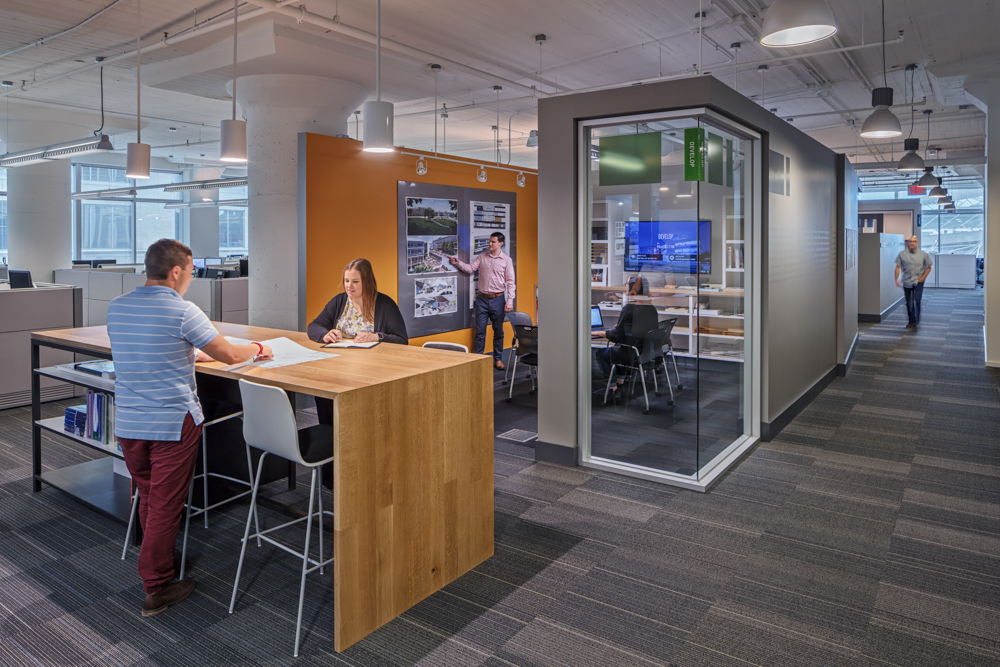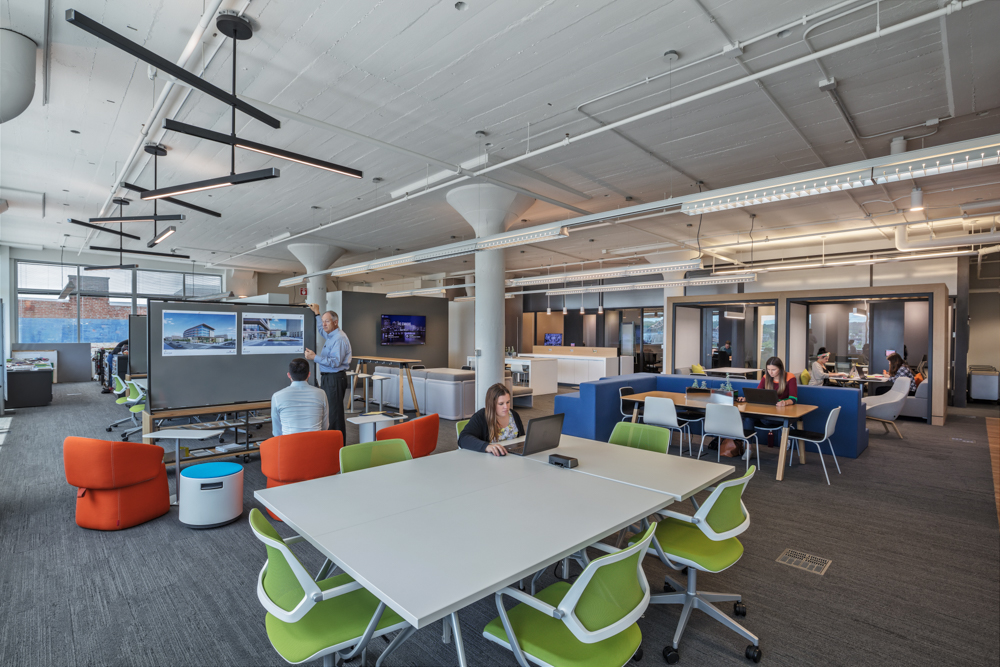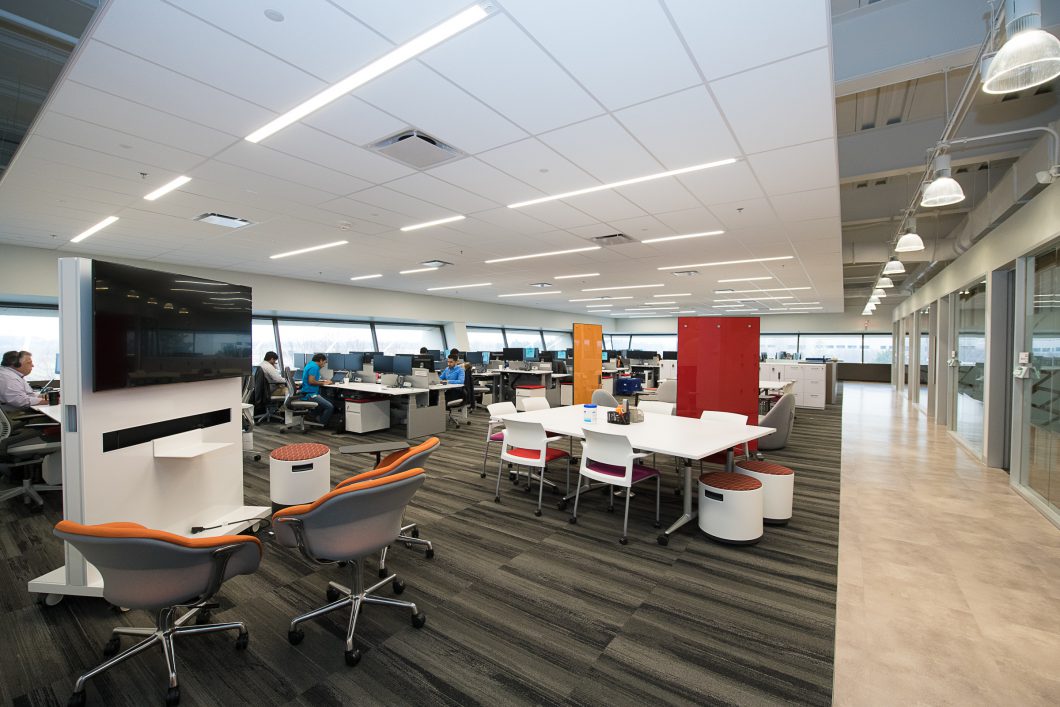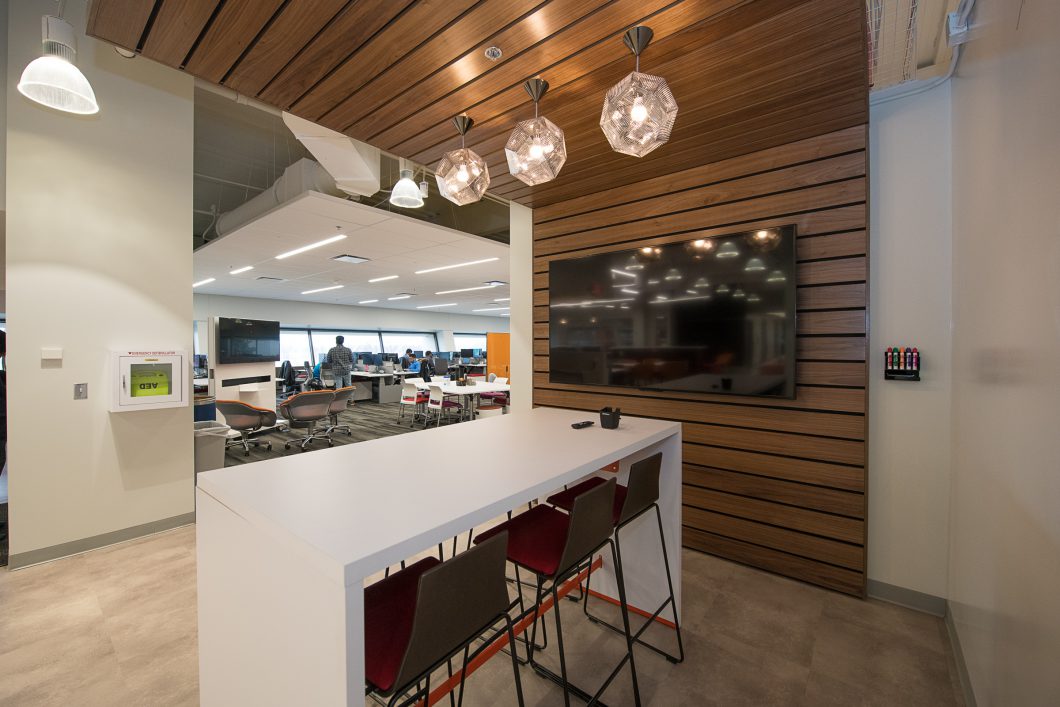
Space As A Service: It’s Time To Break The Norm

Multiple drop-in meeting rooms with a variety of tools provide spaces for employees to innovate and collaborate.
Why we should design spaces that are upgradable and adaptable to match the ever-changing organization.
Typically, organizations construct new or update space for their employees as a capital investment. While intended to serve the purpose for the long-term, the reality is as organizations evolve, the space remains stagnant. Then a decade or more later, funds are used again to completely redesign the space.
As a result, the space does not serving the corporation effectively. It’s time to break the norm, implement strategies and design spaces that live and breathe in sync with the organization—spaces that are upgradable and adaptable to match the ever-changing organization. With this model, internal environments are created with the mindset of providing a service. In this way, companies can evaluate the use of the space and easily make changes and enhancements to this asset to better meet the organization’s needs.
What is space as a service?
The common definition of space as a service is the change in the real estate model from asset ownership to monetization of access and services that include physical space. Yet, space as a service is more than just about real estate. It is a model that facilitates a change in management’s beliefs about the design and use of real estate to one that proactively enhances productivity and experiences within a company’s real estate portfolio.
A common question about space as a service is how does real estate create higher profitability by providing more service, experience, and access, instead of focusing on a product packaged for ownership? The answer is by changing the service model to focus on more personal, flexible and tech-centric solutions. In fact, space as a service often includes technology disruptions to an existing market. Primary examples include Amazon in the bookstore/retail space, Airbnb in the hotel space and WeWork in the temporary/flexible office space.

The open space is multifunctional for hosting agile employees and accommodating company meetings and multiple technologies.
The increased speed of business, propelled by ever-changing advancements in technology and compounded by expectations from Wall Street, dramatically impacts the workplace. Technology includes smaller and more powerful personal devices, cloud computing, the Internet of Things, sensors, smart buildings, and artificial intelligence. The cost center capital model of changing a workspace once a decade based on market benchmarking, past experiences, typical rules relating to ratios and relationships, organizational programming and design formulations is outdated. Organizations that want to thrive in this environment must change their mindsets and strategies to incorporate spatial solutions in a space as a service model to provide constant evolution and progress. The new model means delivering spatial solutions that proactively meet employees’ needs over time to support dynamic changing business. This is accomplished by taking into consideration internal cultural aspects as well as external factors related to the company, sometimes without employees recognizing or even realizing they needed these changes. These include the corporate real estate strategy, labor markets and human preferences.
Corporate real estate strategy
The first aspect of space as a service related to the cultural environment involves real estate strategy. Key components of this strategy include:
Corporate real estate (CRE) executives are under pressure to reduce real estate costs during a design or redesign of a workplace. At the same time, they are tasked with increasing employee productivity. A 2015 survey on global corporate real estate trends by Jones Lang LaSalle determined that over 90 percent of companies expect their CRE executives to improve workplace, business, and people productivity. At the same time, the study found that 77 percent of CRE executives face pressure from their senior management to reduce real estate and related costs.
One solution is for CRE executives to incorporate activity-based work to enhance productivity and the use of the workspace. “The Once Alternative Workplaces Strategies” Fifth Biennial Global Benchmarking Study 2018 discovered that the endorsement of alternative workplace programs by executives increased from seven percent in 2009 to 17 percent in 2017. These programs are defined by the study as “the combination of non-traditional work practices, settings and locations that supplement or replace traditional offices.” Without these approaches, a workspace may become stiff and stagnant. Yet, when these elements are incorporated into a workspace, the space can support and enrich the workplace culture by providing employees with the tools to innovate and tackle problems with creative solutions.
- Maximizing utilization of space. Ensure owned and leased assets are in use and eliminate or reduce underperforming or unused space.
- Ensuring a smart investment. Any space acquisition, lease or design update is executed to enhance the business with a positive net present value and clear return of investment.
- Speed to market of the space. Portfolio modifications are performed quickly to limit disruptions and increase the strategy benefits immediately.
- Decreased liability. All facilities are designed to safeguard users’ health, safety and welfare.
- Flexibility to adjust to changing business needs, including mergers and acquisitions. In a constantly fluctuating environment, multiple organizations may need to manage assets together to improve efficiencies.
- Upkeep and maintenance. Routine and large-scale building-related maintenance tasks are performed on a regular schedule to extend the life of the space.
Corporate real estate (CRE) executives are under pressure to reduce real estate costs during a design or redesign of a workplace. At the same time, they are tasked with increasing employee productivity. A 2015 survey on global corporate real estate trends by Jones Lang LaSalle determined that over 90 percent of companies expect their CRE executives to improve workplace, business, and people productivity. At the same time, the study found that 77 percent of CRE executives face pressure from their senior management to reduce real estate and related costs.
One solution is for CRE executives to incorporate activity-based work to enhance productivity and the use of the workspace. “The Once Alternative Workplaces Strategies” Fifth Biennial Global Benchmarking Study 2018 discovered that the endorsement of alternative workplace programs by executives increased from seven percent in 2009 to 17 percent in 2017. These programs are defined by the study as “the combination of non-traditional work practices, settings and locations that supplement or replace traditional offices.” Without these approaches, a workspace may become stiff and stagnant. Yet, when these elements are incorporated into a workspace, the space can support and enrich the workplace culture by providing employees with the tools to innovate and tackle problems with creative solutions.

Incorporating activity-based work settings enhances productivity and collaboration by providing the spaces preferred for different types of work styles.
Labor markets
In a tight labor market, there is increased competition for high-performing employees. Designing space as a service assists with attracting and retaining new talent. Employees care about working in an invigorating space. Also, they appreciate the flexibility to work anywhere, to balance their work-life demands. According to the 2017 State of Telecommuting in the U.S. Employee Workforce report, regular telecommuting grew 115 percent in the past decade, and 40 percent more U.S. employees offered flexible workplace options than they did in 2010.
The emergence of the gig economy, where many of the jobs are freelance or short-term contracts instead of permanent ones, also dictates the way a space can be designed. According to the U.S. Government Accountability Office, in 2015, contingent workers accounted for approximately 40 percent of the U.S. labor force. Static and permanent offices may not appeal to this workforce. Instead, there is an appreciation for proximity, convenience and hospitality related to where employees prefer to work. The 2015 PGi Global Telework Survey found that in North America, remote workers preferred to work from a home office (63 percent), a local coffee shop (nine percent) and a shared workplace (nine percent). Offering workspace flexibility and telecommuting provides organizations with strategic advantages to attract and retain skilled labor, increase employee engagement and reduce employee stress, absenteeism, and work-life conflict.
Human preferences
As the workforce shifts, so do employees’ preferences. Younger generations demand change and are stifled by old-fashioned work environments that haven’t evolved to keep current with the latest technology and other innovations. Employees need the right tools to perform their jobs and functional, modern space where they have some level of personal ownership and control.
The workspace is more than an area occupied by employees. When designed properly, the workspace can increase employee interactions that lead to innovation, productivity and better connection to the organization and coworkers. The findings from a survey conducted with 1,000 employed American adults were reported in a recent article, “The Surprising Power of Simply asking Coworkers How They’re Doing” for the Harvard Business Review. Almost half of the employees surveyed reported feeling physically and emotionally isolated in the workplace. The author stated, “When employees feel like they belong at work, they are more productive, motivated, engaged and 3.5 times more likely to contribute to their fullest potential…” Employees want to feel valued by their organizations. Employers who consider the needs of their employees when designing their workspace can provide the user experience that employees are seeking.

By organizing the space into adjacent neighborhoods, this Fortune 500 company keeps their space flexible and more accessible with a variety of choice in work settings.
People-centric versus project-centric
Designing space as a service is more effective when using a people-centric rather than a project-centric approach. The project-centric method primarily focuses on designing the space for renovation or getting people in the space as quickly as possible, potentially without considering the impact on the people using the space. The attention isn’t about the final results that occur because of how the space was designed. Rather, this method concentrates on how the space can be designed within a specific timeline for a specific cost as a one-time complete solution.
A people-centric approach is different. It addresses the habits, behaviors and needs of the individuals using the space. The goal of the renovation or design of the space is to support the users’ accomplishments and the value they bring both as an individual and as part of the organizational team. Space is designed in such a way to empower and inspire employees to produce results and be successful. Space as a service takes these concepts and overlays the idea of the spatial solution living and changing over time with the organization.
The outdated model of refreshing a space as a point in time capital expenditure without making additional evolutional improvements consistently over time to support a changing organization, especially related to technology, is no longer a viable standard. The use of space is most effective when organizations plan for continual involvement and tweaks to proactively meet the needs of both the organization and its employees. When the design strategy of work “space” is based on a service model supporting the dynamics of people who will use the space, the outcome is increased engagement, satisfaction, happiness, collaboration and innovation for the employees and experience-based solutions and results for the leadership.
Originally published in Work Design Magazine.
